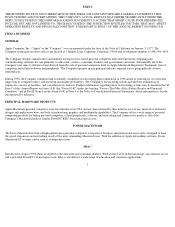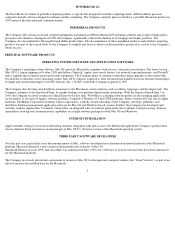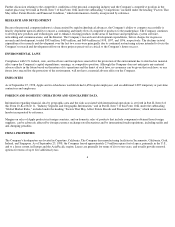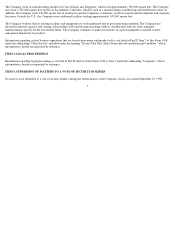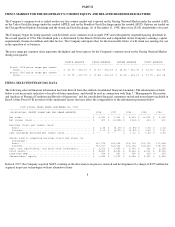Apple 1998 Annual Report Download - page 7
Download and view the complete annual report
Please find page 7 of the 1998 Apple annual report below. You can navigate through the pages in the report by either clicking on the pages listed below, or by using the keyword search tool below to find specific information within the annual report.SEASONAL BUSINESS
Although the Company does not consider its business to be highly seasonal, it has historically experienced increased sales in its first and fourth
fiscal quarters, compared to other quarters in its fiscal year, due to seasonal demand related to the beginning of the school year and the holiday
season. However, past performance should not be considered a reliable indicator of the Company's future revenue or financial performance.
WARRANTY
The Company offers a parts and labor limited warranty on its hardware products. The warranty period is typically one year from the date of
purchase by the end user. The Company also offers a 90-day warranty for Apple service parts used to repair Apple hardware products. In
addition, consumers may purchase extended service coverage on all Apple hardware products.
SIGNIFICANT CUSTOMERS
No customer accounted for more than 10% of the Company's net sales in 1998, 1997 or 1996.
BACKLOG
In the Company's experience, the actual amount of product backlog at any particular time is not a meaningful indication of its future business
prospects. In particular, backlog often increases in anticipation of or immediately following introduction of new products because of
overordering by dealers anticipating shortages. Backlog often is reduced once dealers and customers believe they can obtain sufficient supply.
Because of the foregoing, backlog should not be considered a reliable indicator of the Company's ability to achieve any particular level of
revenue or financial performance.
COMPETITION
The market for the design, manufacture and sale of personal computers and related software and peripheral products is highly competitive. It
continues to be characterized by rapid technological advances in both hardware and software development that have substantially increased the
capabilities and applications of these products, and has resulted in the frequent introduction of new products. The principal competitive factors
in this market are relative price/performance, product quality and reliability, availability of software, product features, marketing and
distribution capability, service and support, availability of hardware peripherals, and corporate reputation.
The Company is currently the primary maker of hardware that uses the Mac OS. The Mac OS has a minority market share in the personal
computer market, which is dominated by makers of computers that run Microsoft operating systems. The Company believes that the Mac OS,
with its perceived advantages over Windows, and the general reluctance of the Macintosh installed base to incur the costs of switching
platforms, have been driving forces behind sales of the Company's personal computer hardware for the past several years. Recent innovations
in the Windows platform, including those included in Windows 98 and Windows NT, or those expected to be included in new versions of
Windows to be introduced in the future, have added features to the Windows platform that make the differences between the Mac OS and
Microsoft's Windows operating systems less significant. The Company is currently taking and will continue to take steps to respond to the
competitive pressures being placed on its personal computer sales as a result of the recent innovations in the Windows platform. The
Company's future consolidated operating results and financial condition are substantially dependent on its ability to continue to develop
improvements to the Macintosh platform in order to maintain perceived functional advantages over competing platforms.
5



